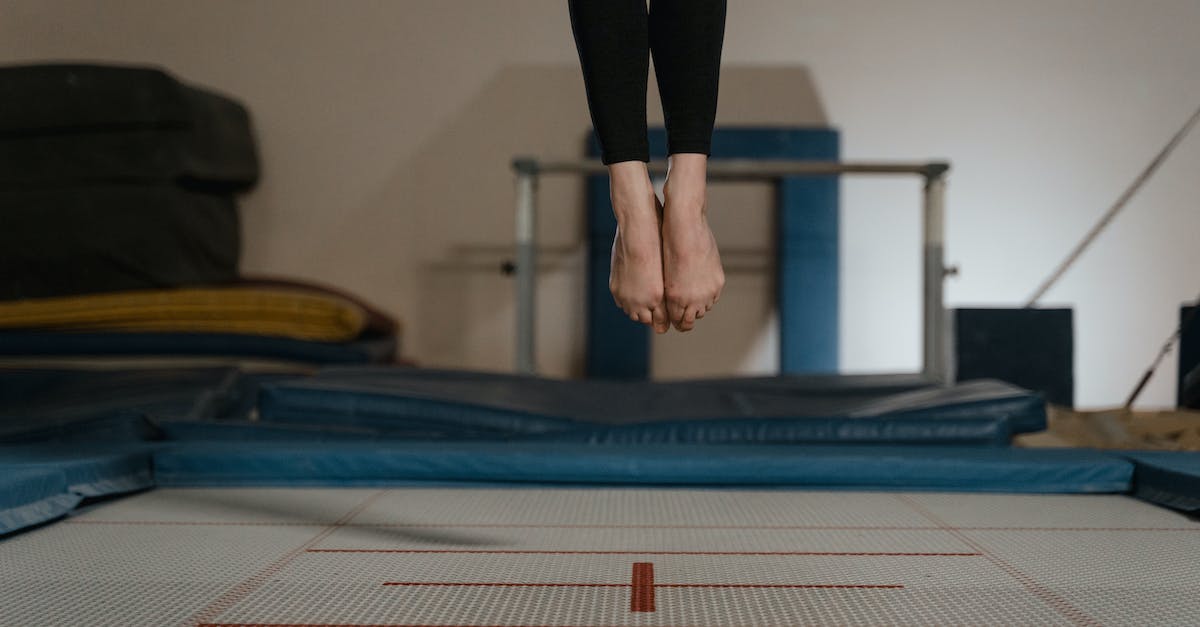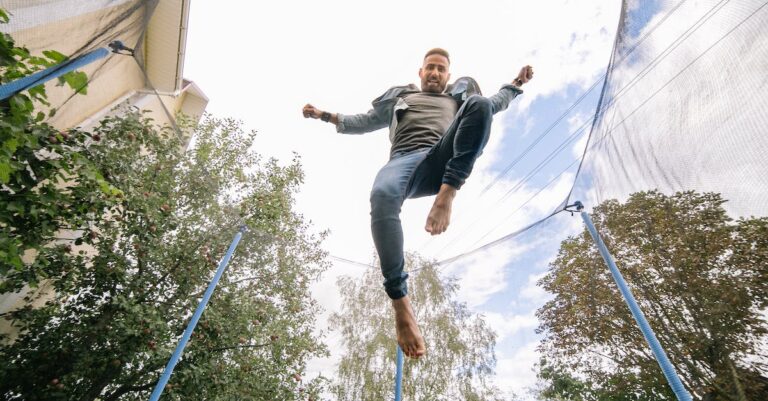The Ultimate Guide to Trampolining: Safety Precautions and Tips
Introduction
What is trampolining?
Trampolining is a popular recreational activity that involves bouncing and performing acrobatic moves on a trampoline. It is a fun and exciting way to improve fitness, coordination, and balance. Trampolining can be enjoyed by people of all ages, from children to adults. However, it is important to take safety precautions to avoid injuries. This article will provide you with essential safety tips and precautions to ensure a safe trampolining experience.
Benefits of trampolining
Trampolining offers a wide range of benefits for both children and adults. One of the major advantages is its ability to improve cardiovascular health and stamina. Jumping on a trampoline increases the heart rate and oxygen flow throughout the body, which helps strengthen the heart and lungs. Additionally, trampolining is a great way to enhance coordination and balance. The constant bouncing and landing on the trampoline require precise movements and control, which can improve motor skills. Moreover, trampolining is a fun and enjoyable activity that can boost mood and reduce stress. The feeling of weightlessness and the release of endorphins during jumping can provide a sense of joy and relaxation. Overall, trampolining is not only a thrilling recreational activity but also a beneficial exercise that promotes physical and mental well-being.
History of trampolining
Trampolining, a popular recreational activity and competitive sport today, has an interesting history that dates back centuries. The concept of bouncing on a flexible surface can be traced back to ancient civilizations, where people used animal skins or stretched fabrics to propel themselves into the air. However, trampolining as we know it today was first introduced in the early 20th century. It was initially used as a training tool for acrobats and gymnasts to improve their aerial skills. Over time, trampolining gained popularity and evolved into a standalone sport, with competitions and specialized equipment. Today, trampolining is not only a thrilling activity but also a recognized Olympic sport, showcasing the incredible athleticism and precision of its participants.
Choosing the Right Trampoline

Size and shape considerations
When it comes to trampolining, size and shape considerations play a crucial role in ensuring a safe and enjoyable experience. The size of the trampoline should be suitable for the available space, taking into account both the width and height measurements. It is important to choose a trampoline that fits well in your backyard or designated area, allowing for sufficient clearance around it. Additionally, the shape of the trampoline can impact the jumping experience. While round trampolines are the most common and provide a consistent bounce, rectangular trampolines offer a higher bounce and are preferred by athletes and gymnasts. Ultimately, considering the size and shape of the trampoline will help you make an informed decision and enhance your trampolining experience.
Weight limit and user capacity
When it comes to trampolining, understanding the weight limit and user capacity is crucial for ensuring a safe and enjoyable experience. Trampolines are designed to support a specific weight limit, which is the maximum weight that the trampoline can safely handle. Exceeding this weight limit can put unnecessary strain on the trampoline and increase the risk of accidents or damage. Additionally, trampolines also have a user capacity, which refers to the maximum number of people that can safely use the trampoline at the same time. It is important to adhere to both the weight limit and user capacity to prevent injuries and maintain the longevity of the trampoline. Before using a trampoline, always check the manufacturer’s guidelines and recommendations regarding weight limits and user capacity to ensure a safe and enjoyable trampolining experience.
Safety features to look for
When looking for a trampoline, it is important to prioritize safety features. These features can greatly reduce the risk of accidents and injuries while using the trampoline. One important safety feature to look for is a sturdy frame made of durable materials such as galvanized steel. This ensures that the trampoline can withstand heavy use and remain stable during jumps. Additionally, a safety enclosure or netting around the trampoline is crucial to prevent users from falling off the trampoline. The netting should be securely attached to the frame and have a zipper or latch for easy access. Another important safety feature is padding or spring covers that protect users from coming into contact with the springs or frame. Look for trampolines with thick and durable padding that can withstand constant use. By considering these safety features, you can ensure a safer trampolining experience for yourself and your family.
Setting Up the Trampoline

Choosing the right location
When choosing the right location for trampolining, there are several factors to consider. Firstly, it is important to find a flat and level surface to ensure stability and safety. Avoid placing the trampoline on uneven ground or slopes, as this can increase the risk of accidents. Additionally, make sure there is enough space around the trampoline to allow for safe jumping and landing. Remove any obstacles or hazards in the vicinity, such as trees, fences, or sharp objects. It is also advisable to place the trampoline in an open area away from buildings or other structures. This will help prevent collisions and provide ample room for movement. By carefully selecting the location for your trampoline, you can create a safe and enjoyable environment for trampolining.
Preparing the ground
Preparing the ground is an essential step before setting up a trampoline. It ensures the safety and stability of the trampoline during use. The first thing to do is to choose a suitable location for the trampoline. It should be a flat and level area, free from any obstacles such as trees, fences, or rocks. Clear the area of any debris or objects that could potentially cause injuries. It is also important to make sure the ground is firm and not prone to sinking or shifting. This can be achieved by placing a layer of protective material, such as rubber mulch or safety mats, underneath the trampoline. Taking these precautions will help create a safe and enjoyable trampolining experience for everyone.
Assembling the trampoline
Assembling the trampoline is an important step in ensuring a safe and enjoyable trampolining experience. Before starting, carefully read the manufacturer’s instructions and gather all the necessary tools and parts. Begin by laying out the trampoline frame and attaching the legs securely. Then, connect the springs to the frame, making sure they are evenly spaced. Finally, attach the jumping mat and safety enclosure, double-checking that they are properly secured. Taking the time to assemble the trampoline correctly will help prevent accidents and ensure that it is stable and sturdy for use.
Safety Precautions

Supervision and age restrictions
When it comes to trampolining, supervision and age restrictions play a crucial role in ensuring the safety of all participants. It is important to have a responsible adult present at all times to supervise the activities and enforce the necessary safety precautions. Additionally, age restrictions should be strictly followed to prevent young children from engaging in activities that may be too advanced or risky for their age group. By adhering to proper supervision and age restrictions, trampolining can be enjoyed safely by people of all ages.
Proper clothing and accessories
When it comes to trampolining, wearing the proper clothing and accessories is essential for both safety and performance. It is important to wear comfortable and fitted clothing that allows for unrestricted movement. Loose clothing can get caught in the trampoline springs or cause tripping hazards. Additionally, wearing supportive athletic shoes can help provide stability and reduce the risk of foot injuries. It is also recommended to wear a safety helmet to protect the head from potential falls or collisions. By wearing the right clothing and accessories, trampolinists can enjoy a safe and enjoyable experience while bouncing on the trampoline.
Warm-up exercises
Before jumping on a trampoline, it is important to warm up your body to prevent any potential injuries. Warm-up exercises help to increase blood flow, loosen up muscles, and prepare your body for the physical activity ahead. Some effective warm-up exercises for trampolining include jogging in place, jumping jacks, arm circles, and leg swings. These exercises help to activate different muscle groups and improve flexibility. Remember to start with gentle movements and gradually increase the intensity. By incorporating warm-up exercises into your trampolining routine, you can ensure a safer and more enjoyable experience.
Basic Trampolining Techniques

Bouncing and jumping
Bouncing and jumping are the core elements of trampolining that bring joy and excitement to participants of all ages. However, it is important to approach these activities with caution and adhere to safety precautions. When bouncing on a trampoline, it is essential to maintain control and avoid reckless behavior. Always ensure that the trampoline is in good condition, with no tears or damages, and that it is placed on a level surface away from any obstructions. Additionally, it is crucial to jump in the center of the trampoline and avoid jumping too high, as this can increase the risk of injury. By following these safety measures, trampolining can be a fun and safe activity for everyone to enjoy.
Front and back flips
Front and back flips are some of the most exciting and challenging trampoline tricks. These acrobatic moves require a combination of strength, technique, and coordination. When attempting a front flip, it is important to tuck your knees to your chest and use your abdominal muscles to rotate your body forward. Safety is paramount, so always make sure to have a spotter and practice on a well-maintained trampoline. Back flips, on the other hand, involve flipping backward while maintaining control and balance. It is crucial to jump high and initiate the flip with a strong push from your legs. Remember to always follow proper progressions and seek guidance from a qualified instructor. With practice and proper precautions, front and back flips can be thrilling accomplishments on the trampoline.
Twists and somersaults
Twists and somersaults are advanced trampoline tricks that require skill and precision. These moves add an exciting element to trampolining but also come with increased risks. It is crucial to master basic trampoline skills and have a solid understanding of body control before attempting twists and somersaults. Always ensure that the trampoline is in good condition and properly set up, with safety nets and padding in place. Additionally, it is important to have a spotter present when attempting these tricks, someone who can provide guidance and assistance if needed. Remember to start with small, controlled movements and gradually progress to more complex tricks. Practice in a controlled environment and always prioritize safety when attempting twists and somersaults on a trampoline.
Common Trampolining Injuries and Prevention

Sprains and strains
Sprains and strains are common injuries that can occur while trampolining. A sprain is a stretching or tearing of ligaments, while a strain is a stretching or tearing of muscles or tendons. These injuries can happen when landing awkwardly, jumping too high, or performing flips and tricks without proper technique. To prevent sprains and strains, it is important to warm up before trampolining, use proper jumping techniques, and avoid pushing your body beyond its limits. If an injury does occur, it is essential to rest, ice, compress, and elevate the affected area to reduce swelling and promote healing. Seeking medical attention may be necessary for severe sprains or strains.
Fractures and dislocations
Fractures and dislocations are some of the most common injuries associated with trampolining. The high impact and repetitive bouncing on the trampoline can put a lot of stress on the bones and joints, increasing the risk of fractures and dislocations. It is essential to follow proper safety precautions and techniques to minimize the chances of these injuries. Wearing protective gear, such as padded clothing and helmets, can provide an extra layer of protection. Additionally, learning and practicing proper landing techniques can help reduce the impact on the body and prevent fractures and dislocations. It is also crucial to ensure that the trampoline is in good condition and properly maintained to avoid any potential hazards. By being aware of the risks and taking necessary precautions, trampoliners can enjoy this fun activity while keeping themselves safe from fractures and dislocations.
Safety tips to prevent injuries
Trampolining is a fun and exhilarating activity, but it is important to prioritize safety to prevent injuries. Here are some essential safety tips to keep in mind while trampolining. First and foremost, always ensure that the trampoline is set up on a flat and level surface, away from any obstacles or hazards. It is also crucial to have proper padding and safety nets installed around the trampoline to minimize the risk of falling off. Additionally, make sure to regularly inspect the trampoline for any damages or wear and tear, and promptly address any issues. Furthermore, only allow one person to jump on the trampoline at a time to avoid collisions and accidents. Lastly, it is vital to supervise children at all times while they are trampolining to ensure their safety. By following these safety tips, you can enjoy the excitement of trampolining while minimizing the risk of injuries.







